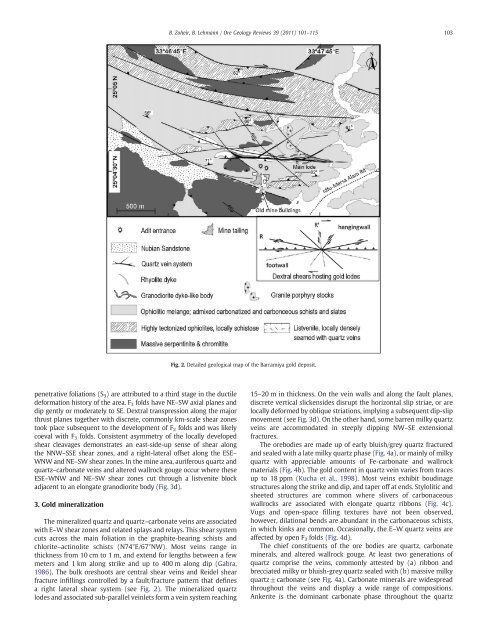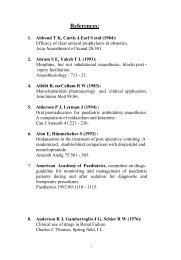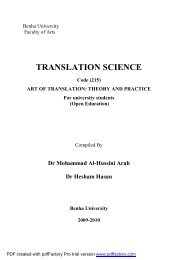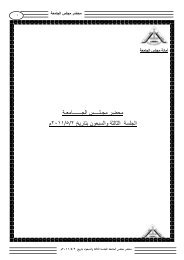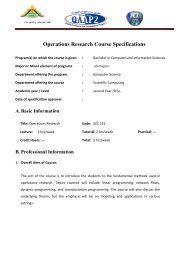Basem Ahmed Zoheir_Barramiya, OGR_2011.pdf
Basem Ahmed Zoheir_Barramiya, OGR_2011.pdf
Basem Ahmed Zoheir_Barramiya, OGR_2011.pdf
Create successful ePaper yourself
Turn your PDF publications into a flip-book with our unique Google optimized e-Paper software.
penetrative foliations (S 3) are attributed to a third stage in the ductile<br />
deformation history of the area. F3 folds have NE–SW axial planes and<br />
dip gently or moderately to SE. Dextral transpression along the major<br />
thrust planes together with discrete, commonly km-scale shear zones<br />
took place subsequent to the development of F 2 folds and was likely<br />
coeval with F3 folds. Consistent asymmetry of the locally developed<br />
shear cleavages demonstrates an east-side-up sense of shear along<br />
the NNW–SSE shear zones, and a right-lateral offset along the ESE–<br />
WNW and NE–SW shear zones. In the mine area, auriferous quartz and<br />
quartz–carbonate veins and altered wallrock gouge occur where these<br />
ESE–WNW and NE–SW shear zones cut through a listvenite block<br />
adjacent to an elongate granodiorite body (Fig. 3d).<br />
3. Gold mineralization<br />
The mineralized quartz and quartz–carbonate veins are associated<br />
with E–W shear zones and related splays and relays. This shear system<br />
cuts across the main foliation in the graphite-bearing schists and<br />
chlorite–actinolite schists (N74°E/67°NW). Most veins range in<br />
thickness from 10 cm to 1 m, and extend for lengths between a few<br />
meters and 1 km along strike and up to 400 m along dip (Gabra,<br />
1986). The bulk oreshoots are central shear veins and Reidel shear<br />
fracture infillings controlled by a fault/fracture pattern that defines<br />
a right lateral shear system (see Fig. 2). The mineralized quartz<br />
lodes and associated sub-parallel veinlets form a vein system reaching<br />
B. <strong>Zoheir</strong>, B. Lehmann / Ore Geology Reviews 39 (2011) 101–115<br />
Fig. 2. Detailed geological map of the <strong>Barramiya</strong> gold deposit.<br />
15–20 m in thickness. On the vein walls and along the fault planes,<br />
discrete vertical slickensides disrupt the horizontal slip striae, or are<br />
locally deformed by oblique striations, implying a subsequent dip-slip<br />
movement (see Fig. 3d). On the other hand, some barren milky quartz<br />
veins are accommodated in steeply dipping NW–SE extensional<br />
fractures.<br />
The orebodies are made up of early bluish/grey quartz fractured<br />
and sealed with a late milky quartz phase (Fig. 4a), or mainly of milky<br />
quartz with appreciable amounts of Fe-carbonate and wallrock<br />
materials (Fig. 4b). The gold content in quartz vein varies from traces<br />
up to 18 ppm (Kucha et al., 1998). Most veins exhibit boudinage<br />
structures along the strike and dip, and taper off at ends. Stylolitic and<br />
sheeted structures are common where slivers of carbonaceous<br />
wallrocks are associated with elongate quartz ribbons (Fig. 4c).<br />
Vugs and open-space filling textures have not been observed,<br />
however, dilational bends are abundant in the carbonaceous schists,<br />
in which kinks are common. Occasionally, the E–W quartz veins are<br />
affected by open F3 folds (Fig. 4d).<br />
The chief constituents of the ore bodies are quartz, carbonate<br />
minerals, and altered wallrock gouge. At least two generations of<br />
quartz comprise the veins, commonly attested by (a) ribbon and<br />
brecciated milky or bluish-grey quartz sealed with (b) massive milky<br />
quartz±carbonate (see Fig. 4a). Carbonate minerals are widespread<br />
throughout the veins and display a wide range of compositions.<br />
Ankerite is the dominant carbonate phase throughout the quartz<br />
103


